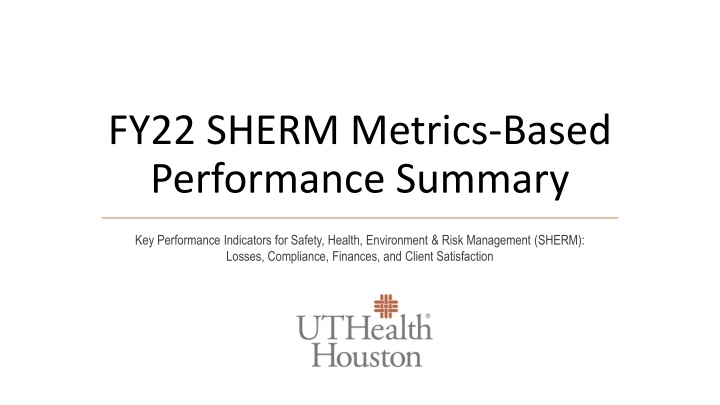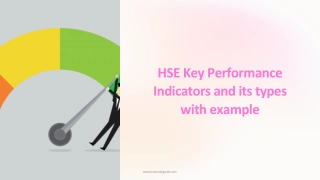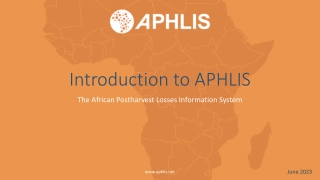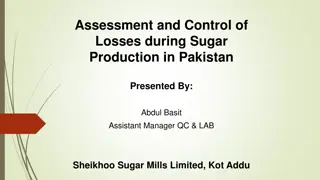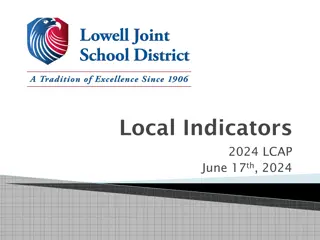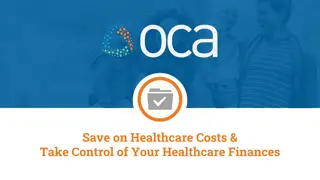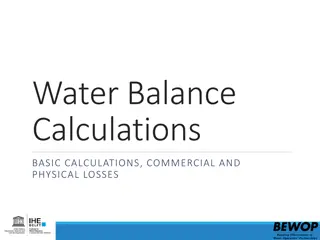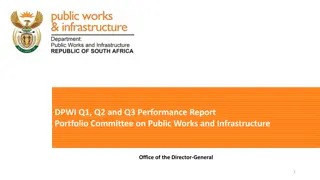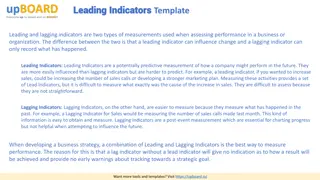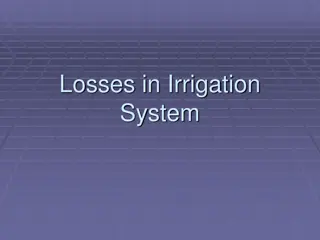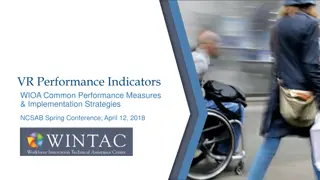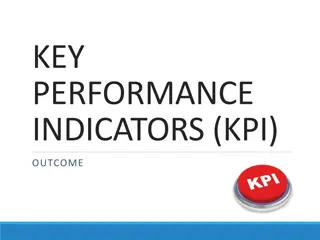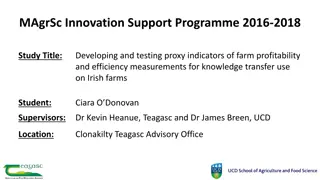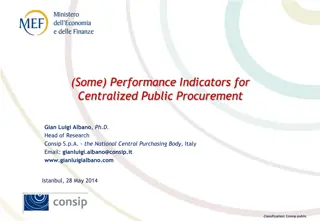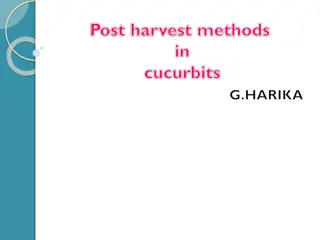Key Performance Indicators for Safety Services: Losses, Compliance, Finances & Satisfaction
This report covers the key performance indicators (KPIs) related to safety services provided by SHERM, focusing on losses, compliance with external agencies, finances, and client satisfaction. It delves into metrics such as personnel injuries, property losses, compliance assessments, and client service satisfaction to evaluate the overall performance in safety management.
Download Presentation

Please find below an Image/Link to download the presentation.
The content on the website is provided AS IS for your information and personal use only. It may not be sold, licensed, or shared on other websites without obtaining consent from the author.If you encounter any issues during the download, it is possible that the publisher has removed the file from their server.
You are allowed to download the files provided on this website for personal or commercial use, subject to the condition that they are used lawfully. All files are the property of their respective owners.
The content on the website is provided AS IS for your information and personal use only. It may not be sold, licensed, or shared on other websites without obtaining consent from the author.
E N D
Presentation Transcript
FY22 SHERM Metrics-Based Performance Summary Key Performance Indicators for Safety, Health, Environment & Risk Management (SHERM): Losses, Compliance, Finances, and Client Satisfaction
UTHealth Houston Institutional Missions and SHERM s Role, Contributions UTHealth Houston institutional missions: Teaching Research Service Service to the Institution (SHERM s primary role) 4 Key Performance Indicators (KPI) of safety services provided Service to the Community SHERM also contributes to the other key institutional missions as well
Languishing Impacts of the COVID-19 Pandemic The COVID-19 pandemic has persisted throughout FY22, therefore impacts to departmental operations and services due to COVID-19 are specifically highlighted and addressed in this report Many services continue to be dramatically increased Some normal operations and services are (must be) continuously maintained Some services remain reduced or continue to be deferred until a later time period As essential personnel, SHERM staff have remained physically on campus during the entirety of FY22 to serve the institution Despite the continued meritorious dedication and service to the institution, many SHERM staff have been affected personally and professionally by the pandemic. Therefore the health and wellness of our staff has been, and will continue to remain, a top priority throughout FY23.
SHERMs Four Key Performance Indicators (KPI) for Safety Services to the Institution KPI #2 Compliance With external agencies With internal assessments KPI #1 Losses Personnel Property KPI #3 Finances Expenditures Revenues KPI #4 Client Satisfaction External clients served Internal department staff
KPI #1: Losses Personnel Numbers of first reports of injury submitted by employees, residents, students Number of reported employee injuries and illnesses requiring medical treatment Workers Compensation Insurance experience modifier Property Losses incurred and covered by UTS Comprehensive Property Protection Program Losses incurred but covered by outside party Losses retained by UTHealth Houston
Number of First Reports of Injury, by Population Type, FY01 FY22 (estimated total population = 15,894; employees: 10,136; students: 5,758) 800 Medical Residents transitioned to become Employees Oversight by SHERM 700 NOTE: UTHealth Houston population headcount increased 39% between FY14 to FY22 600 500 Number of First Reports 400 Total n= 364 Employees n= 345 300 200 100 Students n= 19 Residents n= 0 0 FY01 FY02 FY03 FY04 FY05 FY06 FY07 FY08 FY09 FY10 FY11 FY12 FY13 FY14 FY15 FY16 FY17 FY18 FY19 FY20 FY21 FY22 Fiscal Year
Total Number of Employee First Reports of Injury and Subset of Compensable Claims Submitted to UT System, FY03 to FY22 Medical Residents transitioned to become Employees NOTE: UTHealth Houston employee headcount increased 42% between FY14 to FY22 Oversight by SHERM 400 350 300 Number of reports with no medical claims 250 200 150 Number of reports with medical claims 100 50 0 FY04 FY05 FY06 FY07 FY08 FY09 FY10 FY11 FY12 FY13 FY14 FY15 FY16 FY17 FY18 FY19 FY20 FY21 FY22 *Increase in UTP clinics has resulted in greater risk of injury due to higher clinical injury exposures
Annual UTHealth Houston Incidence Rate of Reported Employee Injuries and Illnesses Compared to National Hospital and University Rates (national data source: US Bureau of Labor Statistics) Annual Reported Injury/Illness Rates 8 Hospitals NAICS 622 7 Injury/Illness Rate per 100 Full Time Workers 6 NOTE: National data for FY21 reflects impacts of COVID-19 on hospitals and decreases on universities due to remote learning 5 4 3 2 Universities NAICS 6113 1 UTHealth Houston 0 FY07 FY08 FY09 FY10 FY11 FY12 FY13 FY14 FY15 FY16 FY17 FY18 FY19 FY20 FY21 FY22
Workers Compensation Insurance Premium Experience Modifier for UT System Health Institutions Fiscal Years 03 to 22 (premium rating based on a three year rolling average as compared to a baseline of 1.00) 0.60 Oversight by SHERM Medical Residents transitioned to become Employees 0.50 0.40 0.30 0.20 UTMB (0.133) UTHealth San Antonio (0.104) 0.10 UTHealth Tyler (0.092) UTSWMCD (.086) UTHealth Houston (.068) UTMDACC (0.047) 0.00 FY03 FY04 FY05 FY06 FY07 FY08 FY09 FY10 FY11 FY12 FY13 FY14 FY15 FY16 FY17 FY18 FY19 FY20 FY21 FY22 Fiscal Year
FY22 Retained Property Losses Retained Loss Cost Summary by Peril Notable Retained Losses (inclusive of insurance deductibles) (Total FY22 retained losses = $178,450) Type Location Date Cost Auto Field 9/9/21 $1,000 Hurricane HCPC 9/14/21 $10,000 Water Hurricane Water MSB 9/27/21 $250 Auto Field 11/10/21 $1,000 Water OCB 12/9/21 $200 Mold Auto* Field 12/20/21 $116,000 Water MSB 1/18/22 $500 Water MSB 4/13/22 $500 Mold UCT 5/21/22 $45,000 Auto MSB 7/12/22 $2,000 Water UCT 7/28/22 $2,000 TOTAL $178,450 Losses incurred and covered by third party Water-------------4/2022 $500 Auto---------------7/2022 $1,960 Auto* Losses incurred and covered by UTS insurance Auto-------------9/2021 $7,654 Auto------------11/2021 $1,446 *Total loss of mobile stroke ambulance involved in motor vehicle accident, inclusive of CT unit on board
UTHealth Houston Total Property Retained Loss Summary by Peril and Value, FY06 to FY22 $900,000 $800,000 $700,000 Freeze*** Hurricane** $600,000 $500,000 Lightning/ Fire* $400,000 $300,000 Hurricane $200,000 Water $100,000 $0 FY06 FY07 FY08 FY09 FY10 FY11 FY12 FY13 Fiscal Year FY14 FY15 FY16 FY17 FY18 FY19 FY20 FY21 FY22 *FY15 Lightning strike caused fire damage at student housing totaling $978K loss, with retained loss total at $417K **FY17 Hurricane Harvey losses totaling $12.6M, with retained loss total estimated at $4.8M ***FY21 Winter Storm Uri impacted all UT System institutions across the State of Texas
FY23 Planned Actions - Losses Personnel Closely monitor increase in reported employee injury events (largely from the clinic setting) determine root cause and implement preventive measures; this is particularly important as expansion occurs in areas of special consideration such as the new Dunn Behavioral Sciences facility Re-evaluating slip, trip, and fall data to focus on particular trends and locations; provide interventions to prevent recurrence where possible Continue to focus on sharps injury and bloodborne pathogens exposure prevention, especially with post-exposure prophylaxis costs continuing to increase and changed coverage for medical residents in FY21 impacting ability to reimburse for these costs (e.g. increase in retained losses) Property Re-emphasize focus on prevention and effective management of property insurance claims given recent increase in deductible from $250K to $500K per occurrence Continue with successful efforts to educate faculty and staff about common perils causing losses (water, power interruption, and theft), simple interventions Develop additional predictive methods for prompt recovery after losses occur, specifically estimated length of time to recovery Continue to refine and improve oversight of UTP property loss prevention, mitigation, and insurance program
KPI #2: Compliance With external agencies Regulatory inspections; other compliance related inspections by outside entities With internal assessments Results of EH&S routine safety surveillance activities
External Agencies Inspections n= 13 Date Agency Findings Status 1 Nov. 10, 2021 Texas Department of State Health Services Radiation Control No items of non-compliance (UTHealth, Brownsville CRU, X-ray R10908, Site 024) Inspection file closed 2 Jan. 3, 2022 Texas Department of State Health Services Radiation Control No items of non-compliance (UTHealth, SRB/IMM, X-ray R10908, Site 021) Inspection file closed 3 Jan. 3, 2022 Texas Department of State Health Services Radiation Control No items of non-compliance (UTHealth, MS Complex, X-ray R10908, Site 000) Inspection file closed 4 Jan. 3, 2022 Texas Department of State Health Services Radiation Control No items of non-compliance (UT Physicians, TMC Sports Medicine, Suite 1700, X-ray R26367, Site 032) Inspection file closed 5 Jan. 13, 2022 Texas Department of State Health Services Radiation Control No items of non-compliance (UTHealth, MHH Weatherhead, X-ray R10908, Site 017) Inspection file closed
External Agencies Inspections n= 13 Date Agency Findings Status 6 Jan. 13, 2022 Texas Department of State Health Services Radiation Control No items of non-compliance (UTHealth, MSU Ambulance (inactive), X-ray R10908, Site 026) Inspection file closed 7 Jan. 13, 2022 Texas Department of State Health Services Radiation Control No items of non-compliance (UT Physicians, General Medicine, X-ray R26367, Site 034) Inspection file closed 8 Mar. 29, 2022 Texas Department of State Health Services Radiation Control No items of non-compliance (UTHealth, SRB, Theratronics Reciprocity / Shipment, Broad license for radioactive material, L02774, Site 000) Inspection file closed; irradiator removed under federal NNSA (CIRP) program 9 April 4, 2022 Texas Department of State Health Services Radiation Control No items of non-compliance (UT Physicians, General Medicine, Cardiology, Fannin, Radioactive material license L05465, Site 000) Inspection file closed 10 June 16, 2022 Texas Commission for Environmental Quality (Underground storage tank @ HCPC) No items of non-compliance cited inspector recommended upgrading Class C operator training log. Class C training and training log updated and submitted to TCEQ 6/17/2022. Inspection general closeout letter received July 6, 2022
External Agencies Inspections n= 13 Date Agency Findings Status 11 June 27, 2022 Texas Department of State Health Services Radiation Control No items of non-compliance (UT Physicians, Atascocita Ortho, X-ray R26367, Site 037) Inspection file closed 12 June 28, 2022 Texas Department of State Health Services Radiation Control No items of non-compliance (UT Physicians, Kingwood Ortho, X-ray R26367, Site 036) Inspection file closed 13 August 10, 2022 CDC Etiologic Agent Import Permit Program inspection (UT SPH @ UTRGV Edinberg laboratory) Two primary findings 1) Clarification of BSL3 Manuals and SOPs (UTRGV and Brownsville), and 2) Maintenance items regarding UTRGV BSL3 Response submitted to CDC on November 1, 2022
Routine Internal Compliance Assessments 4,199 workplace assessments documented (approximately 20 per day completed) Progression of routine surveillance program emphasis: labs, clinics, building fire systems, mechanical and non-lab spaces 1,645 deficiencies identified (70% in non-lab spaces) 572 of these deficiencies now corrected to date (represents a decreased efficiency in correcting deficiencies due to challenges of COVID-19 impacts) EHS will continue to focus on assisting with correction of remaining deficiencies Some lab personnel not present onsite to help correct local issues Close out of deficiencies in EHS tracking system also set as a priority for EHS staff Working with FPE to track and report progress and reporting progress to appropriate safety committees 9,899 individuals provided with required safety training 3,685 individuals trained and fit tested for respiratory protection (more than 2X pre-COVID-19 conditions) Clinical based students (e.g. McGovern Medical School, Cizik School of Nursing, School of Dentistry) provided with COVID-19 awareness and PPE training Continued increase in participation in online safety training modules (primarily refresher lab and clinic safety training) Students accessing online safety training content in lieu of in-person training As a result of software upgrades, there is now improved reporting of online safety training between EHS Assistant and HR Learning Management System (Learn 2 Succeed) 86% of PIs have submitted chemical inventories for filing in SHERM database
Respiratory Fit Testing Demands Addressed by EHS at UTHealth Houston, by Fiscal Year 6000 Onset of COVID-19 Pandemic NOTE: Fit testing results in ongoing annual obligation for fit testing refresher 5000 Number of Individuals 4000 3000 2000 1000 0 2017 2018 2019 2020 2021 2022 Fiscal Year
Non-Routine Internal Compliance Activities SHERM has served as a stakeholder in controlled substances working group to address recommended improvements in research and clinical oversight as stated in the findings by the Office of Auditing and Advisory Services (note that DEA registrations are maintained at the individual investigator or clinician level at UTHealth Houston) Plan reviews, code compliance, and safety oversight for construction completion and opening of the new Dunn Behavioral Sciences Center; design scope planning for TMC3 and PHERB projects
FY23 Planned Actions - Compliance External compliance Continue to educate and prepare UTHealth Houston & UTPhysicians clinics about State of Texas Radiation Control program who continue to conduct frequent unannounced x-ray inspections Complete participation in NNSA program to decommission Cesium irradiators (1 device removed in FY22 as part of this program) Provide oversight of proposed withdrawal from Federal Select Agent program due to impending retirement of key faculty Internal compliance Develop efficiencies and strategy for long term management of respiratory protection program since demand remains high Continue aggressive routine surveillance program and incorporate lessons learned from deficiency data into safety training to prevent recurrence Focus on succession planning for specialty positions in SHERM due to anticipated transitions in future Focus on education of research and clinic personnel regarding controlled substances used and stored at UTHealth Houston and UTP Continue to work with FPE to systematically address identified deficiencies and support current projects to address fire safety considerations Provide regular updates to appropriate safety committees Continue emphasis on lab inventories of hazardous materials Continued improvement of chemical inventories Support biosafety awareness and inventory of biological agents and toxins within UTHealth Houston laboratories Focus on controlled substances storage, security, and inventory management and documentation through routine survey process within labs and research units on campus
KPI #3: Finances Expenditures Program cost, cost drivers Revenues Sources of revenue, amounts
Campus Square Footage, SHERM Resource Needs and Funding (modeling not inclusive of resources provided for, or necessary for Employee Health Clinical Services Agreement) Total Assignable Square Footage and Research Subset Modeled SHERM Resource Needs and Institutional Allocations 5000000 Research area (sf) $4,500,000 4500000 Amount Not Funded $4,000,000 4000000 $3,500,000 3500000 $3,000,000 3000000 Institutional Allocation $2,500,000 2500000 $2,000,000 2000000 $1,500,000 1500000 Non- research area (sf) 1000000 $1,000,000 WCI RAP Rebate 500000 $500,000 Contracts & Training 0 $0 FY12 FY13 FY14 FY15 FY16 FY17 FY18 FY19 FY20 FY21 FY22 FY12 FY13 FY14 FY15 FY16 FY17 FY18 FY19 FY20 FY21 FY22 Note: TNASF reported in FY18 & FY19 reduced due to accounting adjustment by FPE Source: FPE, Space Management
Annual Hazardous Wastes Volumes Generated (in pounds) (inclusive of all Hazardous Biological, Chemical, and radioactive Waste Streams) 350,000 300,000 250,000 Total Hazardous Wastes (pounds) 200,000 Pounds 150,000 Biological Wastes (~$0.30/lb.) 100,000 Chemical Wastes (~$2.22/lb.) Radioactive Wastes (~$4.92/lb.) 50,000 0 FY 17 FY 18 FY 19 FY 20 FY 21 FY 22 Cost per pound associated with each waste stream reflects average cost obligations for offsite disposal *Note: Increase in radioactive wastes in FY19 related to compulsory decommissioning of cyclotron unit
Total Hazardous Waste Cost Obligation and Actual Disposal Expenditures (Inclusive of Biological, Chemical, and Radioactive Wastes) $400,000 Note: Increase in hazardous waste costs in FY19 related to compulsory decommissioning of cyclotron unit $350,000 $300,000 $250,000 Total Hazardous Waste Disposal Cost Obligations $160,588 $200,000 $150,000 $100,000 Actual Disposal Expenditures $46,170 $50,000 $0 FY 16 FY 17 FY 18 FY 19 FY 20 FY 21 FY 22 FY22 savings: $114,388 * *Savings represented does not include costs for disposal of Cs137 source covered by participation in the federal CIRP program (~$200,000)
FY22 Revenues Service contracts UT Physicians $800,000 Note: Previous SHERM safety services contract for UTPhysicians was folded into the UTHealth/UTPhysicians MOU on Sept 1, 2020 at a rate of $800,000 per year. This amount includes $137,800 for Occupational Health Program. Continuing education courses/outreach Training, honoraria, peer reviews, fit testing for non-UTHealth Houston personnel $10,000 SHERM staff salary offsets from various research grants $22,590 Total $832,590 NOTE: Above equates to 25% of total SHERM budget for FY22
Safety Support for UT Physicians UTHealth Houston / UTPhysicians MOU SHERM Professional Services Agreement transitioned to UTHealth / UTPhysicians MOU at the request of UTHealth leadership on Sept 1, 2020 Combination of safety, property protection and recovery, insurance, and occupational health services under one contract; safety services include training, radiation safety permitting & surveys, general clinic surveys, fire & life safety surveillance, waste management, emergency preparedness & response, IAQ evaluations, asbestos/mold monitoring, accident/incident investigations, CAP/CLIA quality control monitoring, interface and support to infection prevention and control program, etc. Challenges Continued growth and change of clinical locations and services Tracking and managing all locations with radiation producing devices Emergency management for UTP clinics in different geographic locations (spanning an area roughly the size of the state of Connecticut)
Current UTHealth / UTPhysicians Clinical Footprint UTPhysicians Clinics: UTP clinic locations (n=160) UTP timeshare locations (currently ~30) UTHealth Houston Clinics: UT Health Services Clinic (Employees and Medical Residents) UT Student Health Services Clinic UTSD dental clinics and faculty practice (n=5) Neurosciences (n=15) WIC clinics (n=6) Harris County Psychiatric Center + Dunn Behavioral Science Center (534 total beds)
FY23 Challenges - Financial Current Financial Challenges Continued support for high number of individuals participating in respiratory protection program due to COVID-19 Fit testing and training; sourcing of N95s and other PPE appropriate to protect workers and students from COVID-19 exposure Continued increases in retained loss medical expenses due to transition of UT Medical Foundation residents to UT System workers compensation policy upon becoming UTHealth employees Recent increase in property insurance deductible from $250K to $500K New service contracts in MMS Pathology department likely to lead to 50% increase in chemical waste generation, and therefore result in transition to large quantity generator status; focus will be on reduction and possible safe alternative chemical use for processes for this group Current shortfall in funding for Occupational Health Program $450,000+ currently necessary to run program, increases anticipated due to recent medical resident transition WCI RAP funds being used to support program, but these funds may not be issued again in future $137,800 now coming from UTHealth / UTPhysicians MOU to help support Occupational Health Program
FY23 Planned Actions - Financial Expenditures Continue aggressive hazardous waste minimization program to contain hazardous waste disposal costs Focus on regulated medical waste generation reduction in labs and clinics due to 30% increase experienced during recent (Sept 1, 2019) renewal of UT System-wide contract Fees increase significantly each fiscal year for each point of collection, so primary focus is on minimizing volumes and maximizing efficiency to reduce stop frequencies Continue to lobby for dedicated funding for Occupational Health Clinical Services Agreement because of impending discontinuance of UTS WCI RAP Revenues UTHealth Houston / UTPhysicians MOU now includes occupational health allocation of $138,700 Continue with service contracts and community outreach activities that provide financial support to supplement institutional funding, including enhancing virtual training capabilities Continue to participate in various research grant projects which allow for staff salary offsets Continued receipt of WCI RAP fund allocations in FY22 ($181,676), but program may terminate at any point
KPI #4: Client Satisfaction External clients served Results of Client Satisfaction Survey of Student Services Council membership Internal department staff Summary of ongoing staff professional development activities
Client Feedback Focused assessment of a designated program aspect performed annually: FY03 Clients of Radiation Safety Program FY04 Overall Client Expectations and Fulfillment of Expectations FY05 Clients of Chemical Safety Program Services FY06 Clients of SHERM Administrative Support Staff Services FY07 Feedback from Employees and Supervisors Reporting Injuries FY08 Clients of Environmental Protection Program Services FY09 DMO/ASL Awareness Survey of Level of Informed Risk FY10 Clients of Biological Safety Program Services FY11 Feedback on new UTHealth Houston ALERT emergency notification system FY13 Clients of HCPC Safety Program Services FY14 Student Perception Survey question regarding safety program FY15 Clients of Occupational Safety & Fire Prevention program services FY16 Clients of HCPC Safety Program Services (re-evaluation of services since 2013 implementation) FY17 Area Safety Liaisons FY18 Clients of UTPhysicians Safety Program Services FY19 UTHealth Houston Safety Committee Members (Safety Council, Institutional Biosafety, Chemical Safety, & Radiation Safety Committees) FY20 UT Police at Houston FY21 Center for Laboratory Animal Medicine and Care FY22 Student Services Council Members
Client Satisfaction Survey (FY22) Student Services Council Client Satisfaction Survey Web based survey distributed from August 8 through August 26, 2022 to current Student Services Council members Representing the six UTHealth Houston schools [Survey response rate: 22 out of 67 (33%)] Survey Question Responses Strongly Disagree Strongly Agree Disagree Agree From my perspective as a Student Services Council member, I feel that SHERM generally: 16 (73%) 6 (27%) 1. Provides sufficient information and updates on important student health and safety-related issues? 16 (73%) 6 (27%) 2. Follows up on health and safety concerns raised during Student Services Council meetings? In general, SHERM staff: 10 (45%) 8 (36%) 3. Are easy to contact 11 (50%) 4. Are timely in their response 7 (32%) 16 (73%) 4 (18%) 5. Are courteous 16 (73%) 4 (18%) 6. Are professional 13 (59%) 7 (32%) 7. Are technically competent 13 (59%) 7 (32%) 8. Are knowledgeable about health and safety issues In my school, students generally: 9. Are aware of the safety program at UTHealth Houston 7 (32%) 7 (32%) 13 (59%) 8 (36%) 10. Can access pertinent safety information 7 (32%) 6 (28%) 7 (32%) 9 (41%) 11. Are aware of how to report safety and/or health concerns 1 (5%) 12. Are aware of UTHealth ALERT emergency notification system 4 (18%) 3 (14%) 7 (32%) 13. Are aware of the www.uthealthemergency.org emergency communications webpage 14. Are aware of the new UTHealth Houston mobile app that allows access to important health and safety information found within the campus Emergency Management Plan 5 (23%) 9 (41%) 15. Follow health, safety, and environmental guidelines
Internal Department Staff Satisfaction Continued support of ongoing academic pursuits leverage unique linkage with UT SPH for both staff development and research projects that benefit the institution Weekly continuing education sessions on a wide variety of topics conducted continuously via virtual format during COVID-19 Safety Geek of the Week staff recognition award for superior service delivery Participation in the delivery of UT SPH continuing education course offerings Participation in various UT SPH academic courses Adjunct academic appointments in UT SPH EOHS department for doctorally-prepared staff (n=6) Participation on several health and safety related training grants through UT SPH Active membership, participation, and leadership in professional organizations Participation in invited university EHS program peer reviews Annual conduct of SHERM Mentoring Day where any interested staff member can meet with the VP SHERM to discuss professional development plans and seek advice, suggestions
FY23 Planned Actions Client Satisfaction External Clients Continue with customer service approach to operations Enhancements to client satisfaction survey process and data (results) communication and display Continue collecting data for evidence-based benchmarking to compare safety program staffing, resourcing, performance, and outcomes Survey for FY23 will assess SHERM s interface with Information Technology department Internal Clients (departmental staff) Continue with routine professional development seminars Special focus on emerging issues: development of new training program focused on issues inherent in behavioral healthcare setting Other training topics: safety culture, insider threats, change management, technology in safety (digital safety), worker well being, cultural intelligence, communications, establishing relationships, understanding the exposome, combating fraud in safety Continue with involvement in training courses and outreach activities continued focus on cross training Continue mentoring sessions on academic activities Continue 360o evaluations on supervisors to garner feedback from staff
Institutional Safety Service KPI Caveats Important to remember what isn t effectively captured by these metrics: Increasing complexity of research projects supported Increased collaborations and associated challenges Increased complexity of regulatory environment Impacts of construction both navigation and reviews The pain, suffering, apprehension associated with any injury every dot on the graph is a person The things that didn t happen
SHERM Contribution to the Community Service Institutional Mission Safety, property protection and recovery, and occupational health support to UT Physicians clinical operations Staff membership on local safety committees: Institutional Biosafety Committees (Rice University; University of Houston Downtown ) Radiation Safety Committees (Memorial Hermann Hospital) Delivery of professional continuing education courses through UT SPH Participation in the leadership and management of professional associations by SHERM staff members American Biological Safety Association International Inclusive of peer reviewed journal (Applied Biosafety) Editorial Board Southern Biosafety Association (local affiliate of ABSA - International) State of Texas Chapter of the Health Physics Society American Academy of Health Physics Service in FEMA s ROSS program (Radiological Operations Support Specialist) representing the Greater Houston area, including participation in preparedness drills with TXDSHS, NRC, TDEM, COH officials, etc. Outreach education through invited lectures provided to local and national professional organizations Provision of subject matter expert interviews on safety-related topics to local and national media
SHERM Contribution to the Teaching Institutional Mission UT SPH academic instruction, student advising Several SHERM employees serve in adjunct faculty positions at SPH Guest lectures at other UTHealth Houston schools (MMS and GSBS) and other institutions (US Naval Post Graduate School, TAMU, TSU, UHCL, UHD) Host student internships, practica. Advising for MMS Scholarly Concentration students Continuing education courses through UT SPH Outreach education through courses with professional organizations (HPS, ASSP, ABSA plus several local affiliate chapters, CSHEMA, Eagleson Institute)
SHERM Contribution to the Research Institutional Mission US Public Health Service training grant (w/ Dr. Janelle Rios, UT SPH) NIOSH evaluation of elastomeric respirators in the healthcare setting grant (w/ Dr. Janelle Rios, UTSPH and Dr. Lisa Pompeii, Baylor College of Medicine) Participation in other funded grants: NIOSH ERC SWCOEH TSU Health Physics Program - $11,000 Advising and hosting students for research projects and associated publications: Gutierrez, JM, Emery, RJ. A 30-year radiation safety prospectus describing organizational drivers, program activities, and outcomes, Health Phys, 123(2): 352 -359, 2022 Emery RJ, Wang J, Brown B, Parker S, Inyang O, Rios J. Estimating average university environmental health and safety program staffing and resourcing using a series of Iteratively developed evidence- based models. J Chem Health Saf. 2022 29, 2, 223-229. DOI: 10.1021/acs.chas.1c00087 February 2022. Emery RJ, Patlovich SJ, King KG, Lowe JM, Rios J. Assessing the established competency categories of the biosafety, infection prevention, and public health professions: a guide for addressing needed professional development training for the current and next pandemic. Appl Biosaf 27:2 53-57 2022 https://doi.org/10.1089/apb.2022.0002 Laine J, Delclos GL, EMERY RJ, Peskin M. Health and safety beyond the workplace: training needs for the current and next generation of safety professionals. Prof Saf 67(7) 37-38 2022. Emery RJ, Patlovich SJ, King G, Rios J. Pivoting the biosafety program in response to COVID-19: recommendations of key services and tasks to consider for the next pandemic. Appl Biosaf 27:3 119-126 2022 https://doi.org/10.1089/apb.2022.0009. Emery RJ, Patlovich SJ, Gutierrez JM, Rios J. Considerations for radiation safety professionals to prepare and respond to the next pandemic. Health Phys123(5): 396-401; 2022. Emery RJ, Gillum M*, Gutierrez JM. Basic cyber security considerations for licensees of radioactive materials and registrants of radiation producing devices in an era of remote or hybrid compliance inspections. Health Phys 123(6): 500-502; 2022.
Summary Various measures and metrics indicate that SHERM continues to meet its objective of maintaining a safe and healthy working and learning environment in a cost effective manner that doesn t interfere with operations, while also making active contributions to the institutional missions: Injury rates continue to be among the lowest within the UT System Despite continued growth in the research enterprise, hazardous waste costs aggressively contained Client satisfaction continues to be measurably high And while providing these services, SHERM also actively contributes to the teaching, research, and community service missions of the institution The major area of current institutional growth is in the clinical setting, so SHERM will need to adjust accordingly to support this enterprises The impending discontinuance of the UTS WCI Resource Allocation Program represents a challenge, especially for the Occupational Health program A successful safety program is largely people powered the services most valued by clients cannot be automated! SHERM resource needs will continue to be driven primarily by the square footage to which services are provided (total, lab and clinic square footage) and geographic distribution
